What is a building management statement?
At MRI Software, we are dedicated to clarifying complex property management concepts, including going into detail about what a Building Management Statement is. A BMS is a vital document in facilities management, particularly within mixed-use developments, ensuring coordinated maintenance and access to shared facilities. Our innovative software solutions support these efforts by integrating building management system benefits directly into daily operations through robust building maintenance software.
This strategic integration facilitates seamless property management, enhancing the functionality and efficiency of managing mixed-use properties, simplifying the complexities of modern facilities management for our clients.
How do Building Management Statements Work?
A Building Management Statement (BMS) is a crucial legal document used primarily in properties with multiple types and uses of spaces, such as those combining retail, commercial, and residential areas. It outlines the framework for managing and maintaining shared facilities and services like elevators, staircases, and safety systems, which are essential in multi-use buildings. By setting clear guidelines on access, maintenance, and funding, a BMS helps ensure that all parties involved have a common understanding of their responsibilities and rights, helping to facilitate smoother operations within the property.
The effectiveness of a BMS hinges on its comprehensive nature, encompassing provisions on the supply of services, rights of access, and insurance arrangements, among others. It must be registered over at least two lots, where at least one is a volumetric lot, defined as air space subdivided based on specific survey points. This registration, under laws such as the Land Titles Act 1994, is vital for enforcing the terms of the BMS, particularly in mixed-use buildings where the integration of different space uses could otherwise lead to operational conflicts and administrative challenges.
What Should a Building Management Statement Contain?
A Building Management Statement should include a variety of clauses and components that clearly describe the rights and responsibilities of all parties involved.
Supply of Services to Lots
The inclusion of supply of services to lots in a Building Management Statement is essential as it ensures that all parties understand their rights and responsibilities regarding the provision and usage of essential services like water, electricity, and waste management. This clarity prevents disputes and ensures that services are managed efficiently and equally across all shared facilities.
Specifying these terms helps maintain a consistent quality of services, contributing to the overall functionality and sustainability of the building. It ensures that each occupant or tenant receives reliable access to necessary utilities, which is essential for the smooth operation of multi-use properties.
Rights of Access to Lots
Rights of access to lots in a building management statement clearly defines who can enter certain areas of a property and under what conditions. This is particularly important in buildings with mixed-use spaces, ensuring seamless integration and preventing conflicts among residents, commercial tenants, and retail operators.
Clearly outlined access rights help maintain security and privacy within the building, contributing to a safe and harmonious environment. This provision supports efficient operations and fosters a cooperative atmosphere among all users of the building.
Rights of Support and Shelter
Rights of support and shelter in a building management statement ensures structural integrity and safety across different sections of a property. This clause guarantees that all construction and renovations are undertaken in a manner that supports the stability of the building, safeguarding occupants and property alike.
This inclusion also protects against potential damages from adjacent or connected properties, thereby maintaining the overall well-being and longevity of the building. It ensures a reliable and secure environment for all residents and businesses within the structure.
Insurance Arrangements
Including insurance arrangements in a Building Management Statement is crucial because it ensures that all parts of a property are adequately covered against risks such as fire, flood, or other damages. This provision specifies the type and extent of coverage required, clarifying responsibilities and preventing disputes over claims or liabilities among the various stakeholders.
These arrangements help in the smooth recovery and repair processes following any incident, thereby minimising financial burdens and operational disruptions for the building’s occupants and owners. Proper insurance coverage is key to protecting the property’s value and the interests of all parties involved.
BMS Decision Making
Decision-making within the framework of a Building Management Statement is structured to ensure that all parties involved have representation, typically through designated individuals like a chairperson or elected representatives. This structure facilitates collaborative decision-making on matters impacting the shared facilities and services of the property. Decisions may require majority approval or, in more significant cases, unanimous consent, particularly when changes affect the rights and obligations outlined in the BMS.
Effective decision-making processes are vital for maintaining harmony and operational efficiency within mixed-use properties. They enable timely responses to issues and ensure that adjustments reflect the collective interests of all stakeholders.
BMS Disputes
Building Management Statement disputes can arise from misunderstandings or disagreements over the shared management of property facilities. Effectively resolving these disputes is crucial for maintaining harmony within mixed-use properties.
Common disputes and their resolutions include:
- Access Rights: Ensuring clear signage and updated access controls.
- Service Charges: Regular financial audits and transparent billing processes.
- Maintenance Responsibilities: Clearly defined duties and scheduled inspections.
- Use of Common Areas: Setting rules and usage schedules agreed upon by all parties.
- Alterations to Common Property: Requiring approvals through structured application processes to ensure compliance with the BMS.
Effective dispute resolution requires open communication and adherence to the established guidelines laid out in the BMS, fostering a cooperative environment for all occupants.
Amending a BMS
Amending a Building Management Statement involves a structured process to ensure that all parties agree on the changes and that these modifications serve the collective interest of the property’s stakeholders. Amendments often require unanimous consent among the involved parties, reflecting the critical nature of the changes to shared management and operational guidelines.
Once agreed upon, these amendments are formally documented and registered as supplements to the original BMS. This legal process ensures that all modifications are binding and adhered to, maintaining the integrity and functionality of the management system.
Building Management Statements FAQs
Want to know more about Building Management Statements? Let’s explore some FAQs below.
Facilities Management software
Leading solutions for property occupiers, owners and service providers & contractors.

Contact MRI Software
If you want to find out more about our innovative real estate software solutions, contact us today.
From Trends to Transformations in the Workplace – Uncovering Priorities and Disconnects
In partnership with CoreNet Global, MRI Software conducted a survey of real estate professionals around the world to examine emerging trends in office transformations. These insights provide a global perspective, with input from the APAC, EMEA, North…

